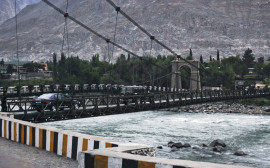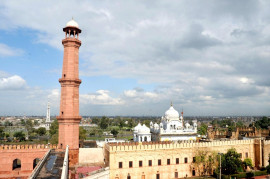
MULTAN:
Seventy per cent work on the conservation and restoration of two gates of the 180-year-old Satgarah Fort in Okara has been completed, an Archaeology Department official said on Thursday.
He said the project had been allocated Rs2.9 million, of which Rs2 million had been utilised.
He said both the gates would be installed by March. The remaining work, including the construction of a second vault at one of the gates, would also be completed by the end of March. The officials said that the contract was awarded in July, 2013.
The fort, built by Maharaja Ranjeet Singh in 1830, has three watch towers. The tomb of Mir Chakar Khan Rind is located at the fourth corner. The officials said that the tomb was built over four centuries ago and had pre-existed.
He said the fort wall was in a dilapidated condition. The Punjab government had allocated Rs2.87 million for archaeological survey and documentation for preparation of a master plan for conservation and development of the area which was once called the Satgarah city. Satgarah, now a village, is located some 17 kilometres from Okara city.

He said the survey and documentation were in progress.
Other monuments to be restored include the 448-year-old tomb of Baloch chieftain and folk hero Mir Chakar Khan Rind and the Satgarah Fort.
The tomb was restored in 2007 under the supervision of a provincial committee, but is still in a dilapidated condition.
At the time of its launch in 2013, the restoration project was proposed to be divided into three phases— protection and rehabilitation of the village under the Punjab Special Premises (Protection) Act 1985 (phase I); restoration of fort wall and other fort structures, preservation of selected village buildings and retaining and protecting the old Satgarah Baloch settlement (phase II); and preservation and restoration of old houses, rehabilitation of village area within the fort as a living monument, and development of tourist facilities like an information centre, landscaped park and outdoor congregation area (phase III).
Published in The Express Tribune, January 24th, 2014.





























































COMMENTS
Comments are moderated and generally will be posted if they are on-topic and not abusive.
For more information, please see our Comments FAQ